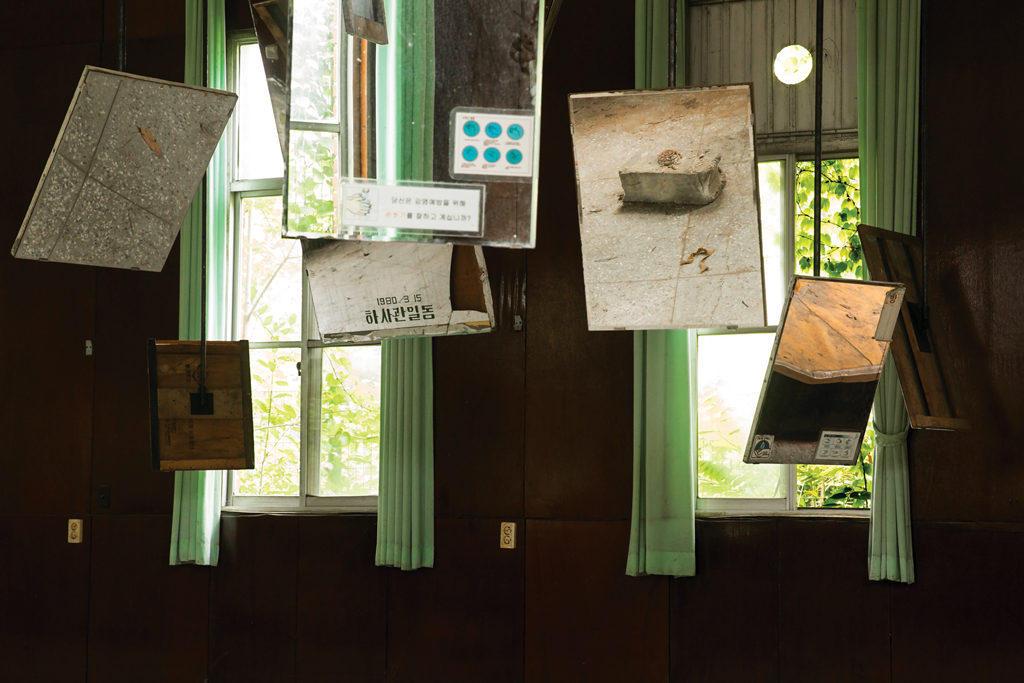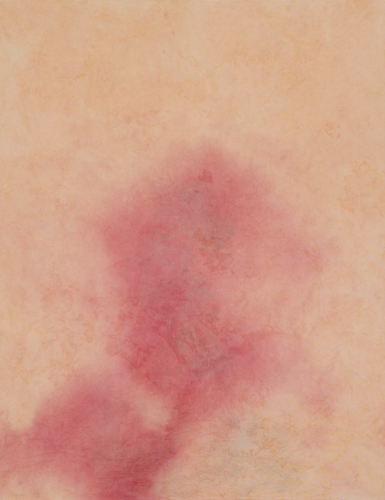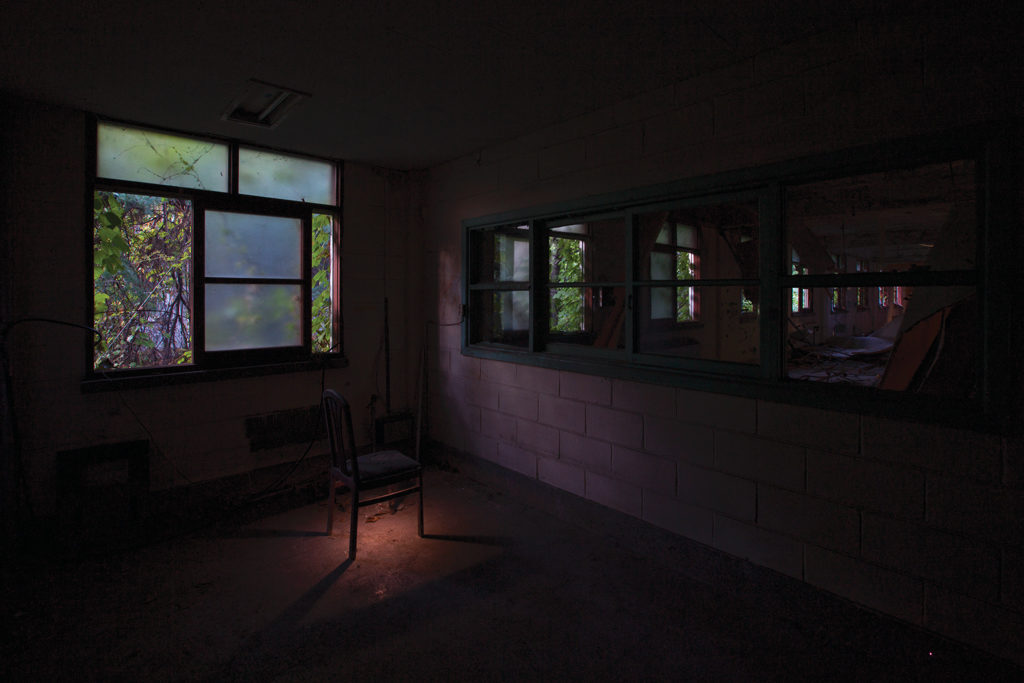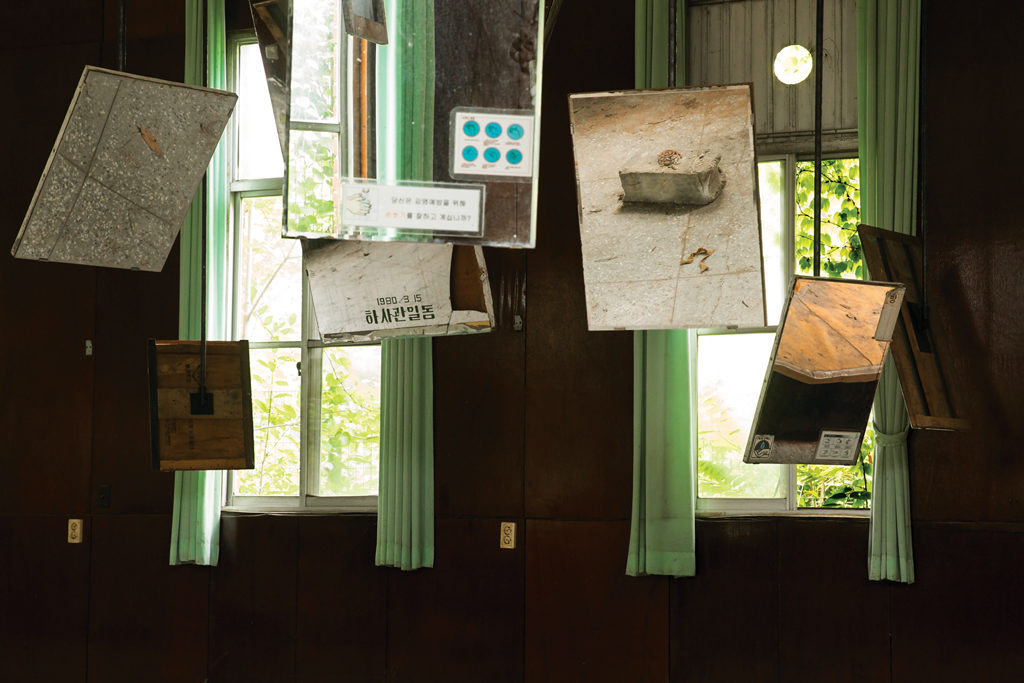[ad_1]

Mike Nelson, Mirror reverb (the blinding of a building, a notation for another), 2018, site-specific installation.
COURTESY THE ARTIST, 303 GALLERY, GALLERIA FRANCO NOERO, MATT’S GALLERY, NEUGERRIEMSCHNEIDER, AND GWANGJU BIENNALE FOUNDATION
An old Chinese adage that ghosts can’t turn corners may explain the labyrinthine layouts of China’s ancient buildings. But ghosts do not manifest themselves physically; a draft may announce the presence of a spirit. The 2018 edition of the Gwangju Biennale is haunted. Wafting through its theme, “Imagined Borders,” is the ghost of the inaugural Biennale, in 1995, which convened under the more affirmative title “Beyond the Borders.”
If that first Biennale celebrated the dawn of globalization, the most recent one (on view through November 11) is more solemn and circumspect, having borne witness to globalization’s consequences—the rise of right-wing regimes, the sealing up of borders, increased policing and surveillance. The Biennale’s 165 artists, whose work is displayed in seven separate exhibitions helmed by eleven curators, served as mediums, channeling stories and myths and demanding a reexamination of history.
Architecture-as-ghost is a theme throughout. The first major space in the Gwangju Biennale Exhibition Hall contains curator Clara Kim’s “Imagined Nations/Modern Utopias” section, where references to Le Corbusier’s Chandigarh and Oscar Niemeyer’s Brasília abounded. Today such modernist constructions appear as eerie, dilapidated monoliths, Kim’s curating emphasizes, but artists are investigating the ways in which they’ve been repurposed. Clarissa Tossin’s Brasília by Foot (2009–13), for example, uses Google Earth images and drawings to trace pedestrian footpaths through the planned capital city’s grid, highlighting informal settlements inhabited by the thousands of migrant workers who built the city. In photographs documenting figurines and other artifacts that have been sealed away in deep storage in the Kuwait National Museum, Alia Farid’s Between Dig and Display (2017) showcases a monument to failed modernity.
Elsewhere, artists demonstrate how architectural plans can be relieved of their functionality, and iconic buildings can be the sites of myth-making. Damián Ortega renders floor plans of modernist houses in supple leather and dangles them from the ceiling like vines (Jirones/Shreds, 2018). Marwa Arsanios’s video installation, Carlton Hotel Project (2008), takes the Beirut Hotel—used as a meeting place for party leaders during the Lebanese civil war and then demolished in 2008 for redevelopment—as the setting for various themes woven around a gay murder mystery.

Bryon Kim, Blue Lift Sandalwood Fall, 2016, dyed canvas, 62¼ x 48 inches.
©BYRON KIM/COURTESY THE ARTIST AND JAMES COHAN, NEW YORK
The “Faultlines” section, situated in the fourth exhibition hall of the Asia Culture Center (ACC) and curated by Yeon Shim Chung and Yeewan Koon, looks at how systems of power manifest themselves at the level of daily decision-making—what Yale University political science theorist James C. Scott calls infrapolitics. Several artists examine the politics underpinning everyday interactions. For his piece Cross Border Convictions: HK/Korea (2018) Hong Kong artist Luke Ching reproduces in a large wall text selections from the charters of civic rules in Korea and Hong Kong, including phrases like “No musical instrument playing in public space” in Hong Kong, “Cannot import small-sized jelly” in Korea. Next to that text is a video in which Ching enacts these prohibited activities and others (flying drones after hours, bringing illegal strong-smelling fruits on trains) in a series of comical vignettes.
Nearby, Byron Kim’s large Bruise Paintings (2018) suggests something more sinister in terms of how trauma lodges in the memory: at first glance, they appear abstract, but soon reveal themselves to be depictions of lesions on human skin. These may heal, but trauma runs deeper.
In the urban landscape surrounding the Biennale, faded love hotels serve as reminders of the rapid expansion of South Korea’s economy during ’90s-era globalization, known locally as segyehwa. The rise of the Biennale was itself a product of that era’s ambitions and is now a reminder of them: Every two years, when artists and critics flock to the city, those hotels temporarily are again flush with capital.
But the “City of Light,” South Korea’s sixth largest metropolis, has other ghosts to contend with. While it appears sleepy compared to Seoul, Gwangju’s placid aura conceals a history of resistance. The student-led protests against the military coup d’état by general Chun Doo-hwan in 1980 roiled the city for nine days, and resulted in the deaths of hundreds of civilians. The May 18 Democratic Uprising is alluded to several times throughout the biennale, particularly in the section called “The Art of Survival: Assembly, Sustainability, Shift” at the ACC, where South Korean artist An Jungju’s film Smoke (2018), brings together extracts from seven other films about the Uprising, focusing on private conversations among witnesses as a means of exploring how historical events are mediated and memorialized. And in the “Returns” section curator David Teh invokes the notion of the “funerary unconscious” in asking whether art can have more than a commemorative function. In doing so, Teh points toward a question that many biennial organizers are asking these days: What can a biennial do for a city like Gwangju after the idealism that bolstered that event’s foundations has diminished?

Apichatpong Weerasethakul, Constellations, 2018, site-specific installation.
COURTESY THE ARTIST AND GWANGJU BIENNALE FOUNDATION
Gwangju’s curators make earnest attempts to address the timely topic of borders (as well as the urgent matters of migration that attend to it), avoiding overly bold claims that might reduce diverse experiences to false equivalences. Instead they seek to demonstrate the ways in which nation-states have mutated and boundaries shifted, revealing themselves as merely constructions. But in assuming a tone and methodology that was mostly retrospective and reflective, the curators fail to show how artists can articulate different structures and play a meaningful role in contentious political times.
If the curators had instead examined how globalization has been transformed from gendered, nonhuman, and environmental perspectives, they might have demonstrated what artists do best: illustrate the ways in which the world can be both fractured and unified along changing lines. It is the four commissioned works at an abandoned military hospital in the southeastern part of the city that rise to this challenge. Viewers are encouraged to arrive at dusk to catch the shimmering oblong shapes cast as the sun’s last rays bounce off British artist Mike Nelson’s Mirror reverb (the blinding of a building, a notation for another), a work made of mirrors Nelson collected on walks through the defunct hospital and hung at various angles from the chapel’s ceiling.
Artist-filmmaker Apichatpong Weerasethakul’s Constellations animates several rooms with discreet interventions, such as billiard balls powered by a concealed mechanism such that they stir at random, as though possessed by otherworldly spirits. In the hospital’s auditorium, Weerasethakul has installed a scrim with verdant depictions of propaganda-esque landscapes that ominously rise and descend to the accompaniment of a victorious brass band soundtrack. Constellations culminates in a room where a partially collapsed ceiling obscures a film projection beyond it. Looking at the screen through a cracked windowpane, you can just barely make out the shape of a human being in motion. Weerasethakul is asking us to see the derelict site anew. Acknowledging the ghosts that surrounded us, he is not merely commemorating the past, but activating it to make space for alternative futures.
A version of this story originally appeared in the Winter 2019 issue of ARTnews on page 115.
[ad_2]
Source link

